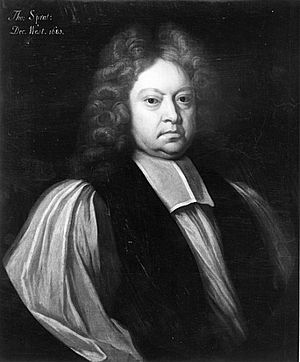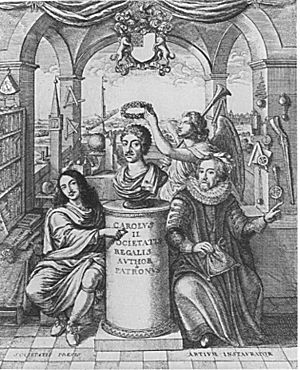Thomas Sprat facts for kids
Quick facts for kids The Right Reverend Thomas Sprat FRS |
|
|---|---|
| Bishop of Rochester | |

Sprat by Michael Dahl
|
|
| Province | Canterbury |
| Diocese | Rochester |
| Enthroned | 1684 |
| Predecessor | Francis Turner |
| Successor | Francis Atterbury |
| Other posts | Dean of Westminster |
| Orders | |
| Ordination | 1660 or earlier |
| Consecration | 1685 |
| Personal details | |
| Born | 1635 Beaminster, Dorset |
| Died | 20 May 1713 (aged 77–78) Bromley, Kent |
| Buried | St Nicholas' Chapel |
| Nationality | English |
| Denomination | Church of England |
| Residence | Bishop's Palace, Bromley |
| Spouse | Helen Wolseley |
| Children | Thomas Sprat FRS, Archdeacon of Rochester |
| Profession | Clergyman |
| Alma mater | Wadham College, Oxford |
Thomas Sprat (1635 – 20 May 1713) was an English church leader and writer. He was a Bishop of Rochester starting in 1684. He was also a Fellow of the Royal Society, which is a group for important scientists.
Contents
Life of Thomas Sprat
Early Life and Education
Thomas Sprat was born in 1635 in a town called Beaminster in Dorset, England. He went to Wadham College, Oxford, a famous university. He was a fellow there from 1657 to 1670. This means he was a special member of the college staff.
Becoming a Church Leader
After his studies, Sprat became a priest. In 1660, he became a "prebendary" at Lincoln Cathedral. This is a type of church official. He was known for his writing and his cleverness.
In 1669, Sprat became a "canon" at Westminster Abbey. A canon is another type of church leader. The next year, he became a "rector" in Uffington. A rector is the main priest of a parish.
Important Roles
Sprat held many important positions in the church. He was a chaplain to King Charles II in 1676. A chaplain is a priest who serves a royal family or an organization.
He became the Dean of Westminster in 1683. The Dean is the head of a cathedral or abbey. In 1684, he was made the Bishop of Rochester. A bishop is a high-ranking church leader who oversees a group of churches.
Working with Kings
Sprat was part of King James II's church committee. He later helped with the crowning of King William and Queen Mary. As Dean of Westminster, he helped Christopher Wren restore Westminster Abbey.
The "Flowerpot Plot"
In 1692, something strange happened. Some people tried to trick the authorities into thinking Sprat was involved in a plot. A man named Robert Young forged Sprat's signature on a document.
Young then hid this fake document under a flowerpot at the Bishop's home. He told the police about it, which led to Sprat's arrest. His house was searched, and the fake document was found.
However, it quickly became clear that the document was a forgery. Sprat was innocent and was set free. This event became known as the "flowerpot plot."
Later Life and Death
Thomas Sprat died in 1713 from a sudden illness. He was 78 years old. He was buried in Westminster Abbey, a very famous church in London.
His Writings

Sprat wrote several important books. One was Observations upon Monsieur de Sorbier's Voyage into England (1665). This book was a funny response to a French writer who had criticized England.
His most famous work is History of the Royal Society of London (1667). Sprat helped start the Royal Society, which is a very old and respected group for scientists.
In this book, he explained the goals of the Royal Society. He also wrote about how scientific writing should be clear and to the point. This helped set the standards for how scientists write today.
He also published a collection of ten of his sermons in 1710. Because of his work on the history of science, he became a Fellow of the Royal Society in 1663.
Family Life
Thomas Sprat was married to Helen Wolseley. They had a son, also named Thomas Sprat. His son also became a church leader and a Fellow of the Royal Society.
After the elder Thomas Sprat died, his son became a canon at Westminster Abbey.
See also
 In Spanish: Thomas Sprat para niños
In Spanish: Thomas Sprat para niños

